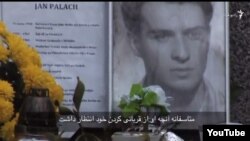Although contemporary Iran and 1960s Czechoslovakia are separated by expanses of time, geography, and culture, Iranian photographer and filmmaker Hasan Sarbakhshian says the story of Jan Palach’s tragic sacrifice is a personal one for him.
“The Brightness of Tomorrow” is the title of Sarbakhshian’s film about the 20-year-old student who committed suicide in January 1969 by self-immolation in protest of the Warsaw Pact invasion of Czechoslovakia.
He begins Palach’s story with the Prague Spring, a brief period of political liberalization in communist Czechoslovakia that was swiftly crushed by an invasion led by the Soviet Union in August 1968. The reform movement had demanded a free press, decentralization of the economy, and more individual rights. On January 16, 1969, the young history student Jan Palach set himself alight on Prague’s Wenceslas Square and died from his injuries a few days later. According to letters he had sent to student leaders and other public figures, he had taken the drastic step in protest of the occupation and censorship regime imposed following the invasion.
Palach’s death sparked an outcry in Czechoslovakia, with his funeral procession becoming a protest march against occupation, and his grave a hero’s shrine. But during the period that followed the occupation, known as “normalization” in the double-speak of the time, the hard-line communist authorities who were restored to power suppressed the truth about Palach’s motivations. They said he was troubled and manipulated by anti-state actors, and even went so far as to secretly remove his remains from their resting place. The distortions of Palach’s act continued until the Velvet Revolution in 1989 that saw the peaceful toppling of the communist regime.
“Fundamentally there is really no difference between the Islamic ideology in Iran and the communist ideology in Czechoslovakia,” said Sarbakhshian. “Both wanted to control and dominate people’s minds. When Russia invaded Czechoslovakia in 1968 they used soldiers and tanks, and in Iran we see a different strategy, but it is the same objective.”
When the film premiered on Radio Farda’s website in September last year, it was clear from the viewer comments that the erasure of history and silencing of truth by the powerful was the aspect of Palach’s story Iranians identified with most.
“While watching this documentary, I sensed the same kind of censorship happening then in Czechoslovakia as now in Iran,” wrote a young woman from Tehran called Sayeh in a Facebook comment.
Sarbakhshian says Iranians old enough to remember will immediately see similarities between events in their own country’s history that are forbidden to speak about now and the way the circumstances of Palach’s death were concealed.
“There is a taboo in talking about the 1980s, when thousands of young dissidents were executed, and even to this day their families don’t have access to their mass graves which are somewhere south of Tehran. If you want to talk about that, you will definitely be punished,” Sarbakhshian said. “And I think the film is interesting for young people who don’t remember the 1979 Revolution in Iran and have only heard the state-sponsored version of events to see how history can be manipulated in another country.”
Judging from the feedback of viewers, the film was not only a case study in the theft of national history by those wielding power, but also an inspiration to work toward a “brighter tomorrow.”
“I learned a lot from this film,” wrote Nooshin, a young artist living in Iran. “Especially about how the Czech people resisted.”
Prior to joining Radio Farda as a freelance filmmaker, Sarbakhshian made documentary films about the Iran-Iraq war in the 1980s and was the AP Tehran bureau photographer from 1999-2009. He also covered the wars in Afghanistan and Iraq. After photographing the Jewish community in Iran, his official press credentials were revoked, and he has lived in exile since 2009. He is currently working on a new film about Iran’s history.
--Emily Thompson






